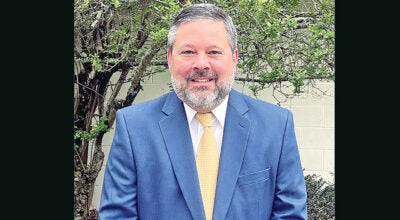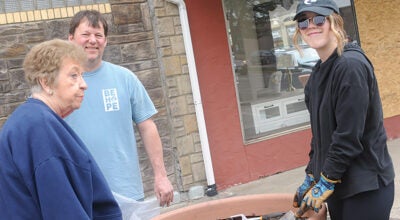Progress vs. Preservation
Published 11:06 pm Saturday, August 22, 2009
SOUTH POINT — An old man sits along the banks of the Ohio River, near the spot everyone calls Virginia Point.
His skin tanned tawny leather by the sun, he dangles a fishing pole into the muddy water, waiting patiently for a hungry fish to beckon.
There’s nothing about the scene that would make a passerby look twice on a sunny day, except for maybe one thing.
That fishing pole isn’t a sleek Bass Pro, not even a makeshift metal rod. It’s just a couple of branches woven together. An odd sight nowadays.
But, wait, look again. Look at the lean-tos dotting the grass behind him. The clothes. The deer hide dangling over a fire pit. This isn’t 2009. It’s circa 3,000 B.C. or 5,000 years ago.
And it was a scene that happened over and over again for thousands of years, all on the same land now carved into grids by railroad tracks and asphalt roads beneath phone lines and power transformers.
The discovery that prehistoric man once camped out on land outside the village of South Point came recently as archaeologists started excavating acreage near the river at what is now called The Point.
Acreage that for almost a century was dedicated not to historic preservation, but to heavy, smelly dirty industry. It’s the same land that today county leaders want to develop again into a range of lucrative jobs, but this time they must do it with an eye for balancing our past with a progressive future.
That’s a balancing act that can mean big bucks spent on historical research for those wanting to develop the land. A reality Dr. Bill Dingus, head of the Lawrence Economic Development Corp., knows full well. So far close to three-quarters of a million dollars have been spent to determine the archaeological significance at The Point.
“In order to have an industrial park, that is part of the cost you have to spend,” Dingus said. “People don’t realize what the state of Ohio does with the ODNR and the Ohio EPA before they will allow you to put an industry on the property.”
It all started in 1966 when an avalanche of historic properties across the United States met their fate with the wrecking ball. That set up a firestorm of protest from the lovers of the country’s past who screamed stop. Congress responded by legislating protection for those structures through the National Preservation Act.
“The law does address it,” Mark Epstein of the Ohio Historic Preservation Office said. “The policy of the U.S. government is that it makes clear preservation of the national heritage is equally as important as providing clean air, appropriate shelter and food to people. When Congress put this together, it was in reaction to things happening in the country that was destroying our heritage. It was an attempt to counter that. Highways and roadways were one of the most destructive.”
Now segue to 2002 when the movers and shakers of Lawrence County see an abandoned section of the county that once attracted thousands of factory workers as a chance to bring growth and economic stability again to the area.
They christen it The Point and start the process of searching for money to turn the land into a clean, modern industrial park.
But before they can do that, they have to check out the dirt they want to build upon, partly because of a law passed almost 40 years ago. Or more precisely Section 106 of that law.
“We can’t develop a section of property until it is cleared by the state,” according to Jeremy Clay, The Point industrial park director.
In other words to get federal funds to build on the land, industrial park officials have to confirm if there is anything of historic significance not just on the property but in it.
“Section 106 is basically one paragraph that federal agencies have to consider the effects of their actions on historic properties, if they are providing assistance in the form of funding or licensing or if they are doing it themselves,” Epstein said.
So a call went out to a private team of archaeologists from Columbus, who for the past seven years have off and on scoured the terrain at The Point looking for any signs of inhabitants of another era.
“Archaeologists have the ability to look at information that is provided to us about the place where this is going to happen and figure the probability of whether there may be archaeological properties present,” Epstein said.
For a while, the scientists from PAST, or Professional Archaeological Service Team, seemed to be just playing in the mud. Then all of a sudden they hit pay dirt. Some pottery shards.
“When we found the pottery, that made us have to do some more work immediately,” Clay said.
Now, a seven-acre section of The Point, directly abutting the river, is dotted with orange-red pennants marking areas where the scientists have determined prehistoric man once trod. The team says they are Native Americans from the Late Archaic and Early Woodland eras, from roughly 6,000 to 2,000 years ago
“They looked like us,” according to David Snyder, archaeology review manager with the preservation office. “If you saw people fishing on the river today they looked like that. We think they were generally mobile, foragers, gatherers, hunters, fishermen. They moved from place to place to take advantage of the resources.”
The scientists believe the land was a camping ground for these natives who would come seasonally possibly to gather from a grove of hickory trees the nuts that were high in protein and fat, seasonal fruit or hunt deer, elk, bison, black bear, turtles and birds.
“The Early Woodlands began a more sedentary lifestyle when these people would camp for longer periods of time,” Dr. Craig Keener, head of the archaeological team at The Point, said. “They would make lean-tos for protection from small saplings for the roof. There were small family groups, extended families who would come here and camp.”
So far, the excavation has yielded pottery, hammer stones used as tools, firebricks and a 3-inch stone ax in pristine condition.
“There have been a few objects that have popped up,” Keener said.
All objects become the property of the state; however it is the goal of the Lawrence Economic Development Corp. to put them on display at the Chamber of Commerce’s office.
All this is fascinating for the archaeologists and history buffs, but how much does this digging slow down the journey of resurrecting The Point or any other development into a viable commercial venue? And for that matter, how much does it destroy what historians would want to preserve?
Those in the preservation business say for the most part not much on both fronts.
“The federal agencies must consider the effect of what they are doing on historic properties,” Epstein said “It makes it clear Indian properties can be destroyed as long as proper mitigation is agreed upon with the parties involved. … Often they can be preserved by removing them from the ground and that is what happened here.”
So except for rare occasions like an Indian burial mound, finding historically significant items won’t stop the commercial development of a property.
“The majority of the projects we are asked to comment on end up with finding no historic properties affected,” Epstein said. “We don’t always know when the project gets underway. When our part of the review (is over) sometimes it surprises us, (the project) in not underway. There may be some lag time.”
Also if there are sections of a site that have no archaeological significance, developers can move ahead there with their plans, Epstein said.
However, developers looking for federal funds can have a different take on the effects of the law.
“It is really unfortunate what you have to do,” Dingus said. “At the same time it is giving the state a great deal of knowledge of the community and the history and the artifacts involved. But I don’t think anyone realizes what it costs to get a piece of commercial land ready for appropriate industrial development. It is a major, major undertaking.
“Sometimes you are getting into years before you break ground. The archaeological work we have been unable to sell the land around County Road 1 or on the river because of this. I accept it as the process of getting the job done.
If we are going to move Lawrence County forward we must play the rules and do this. To find relics of … civilizations who walked on this area thousands of years before Christ, unbelievable finds like that. However it does take time and it is always a balance between the cost and the benefits.”





